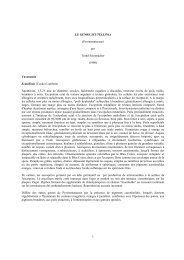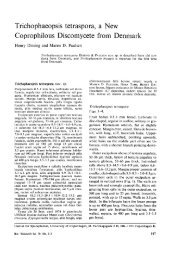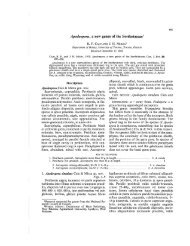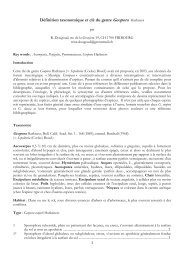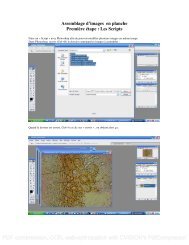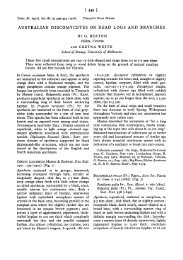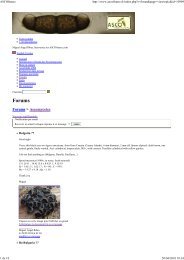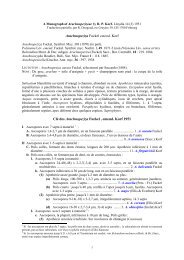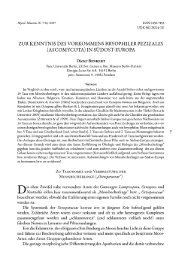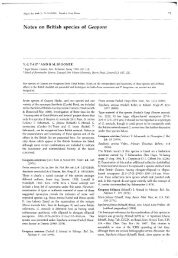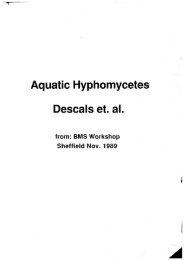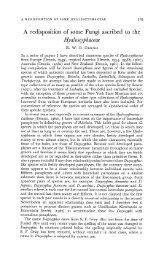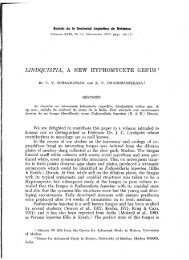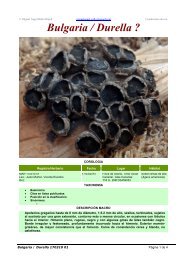Stray Studies in the Coronophorales (Pyrenomycetes) 4-8 - ASCOfrance
Stray Studies in the Coronophorales (Pyrenomycetes) 4-8 - ASCOfrance
Stray Studies in the Coronophorales (Pyrenomycetes) 4-8 - ASCOfrance
You also want an ePaper? Increase the reach of your titles
YUMPU automatically turns print PDFs into web optimized ePapers that Google loves.
<strong>Studies</strong> <strong>in</strong> <strong>the</strong> <strong>Coronophorales</strong> 4-8 291Through <strong>the</strong> courtesy of Dr. Sivanesan I have had access to a fragment of IMI 46511 (a)(unfortunately devoid of asci) and slides of IMI 165 094. The ascocarps resemble <strong>in</strong> shape thoseof Thaxteria and lack certa<strong>in</strong>ly a function<strong>in</strong>g ostiolum, although <strong>the</strong> apical part of <strong>the</strong>ascocarpic locule possesses thick conspicuous periphyses. The rest of <strong>the</strong> locule is l<strong>in</strong>ed by acont<strong>in</strong>uous palisade of asci at very different stages. No apical apparatus has so far beenobserved, but richer material is needed. The peridium shows tendencies to be<strong>in</strong>g slightlyareolate <strong>in</strong> <strong>the</strong> same manner as <strong>in</strong> sundry Lasiosphaeriae and Cercophorae. The cell wallsshow a k<strong>in</strong>d of "Munk pores", but <strong>the</strong>se are smaller than usual and <strong>the</strong> surround<strong>in</strong>g thickenedr<strong>in</strong>g less prom<strong>in</strong>ent.It should also be observed that <strong>the</strong> <strong>in</strong>clusion amongst <strong>the</strong> <strong>Coronophorales</strong>species of Bertia (B. moriformis)of <strong>the</strong> typedoes not mean that o<strong>the</strong>r species placed <strong>in</strong> thatgenus necessarily are of <strong>the</strong> same aff<strong>in</strong>ity. Only three have been exam<strong>in</strong>ed, viz. B.puttemansiiP. Henn. (=Thaxteria archeri, see above), B. italica Sacc. & Speg. andB. (Bertiella) macrospora Sacc. and <strong>the</strong>y were all found to be alien elements, <strong>the</strong>third even bitunicate. The second was synonymized by Mtiller & Arx (1962: 818)with Calyculosphaeria macrospora Fitzp., but this is a true Nitschkia (N.gigantospora).We shall now compare various significant features <strong>in</strong> <strong>the</strong> species studied by me. Itwill <strong>the</strong>n gradually emerge that Fitzpatrick's Nitschkieaeafter some remodell<strong>in</strong>gstands out as a group of <strong>in</strong>ter se closely related species, whose "pattern of variation"suggests a multidimensional letticework of cross<strong>in</strong>g l<strong>in</strong>es (comp. Munk 1962),whereas o<strong>the</strong>r <strong>Coronophorales</strong>take more isolated positions.Mode of growth and ecology. All <strong>Coronophorales</strong>grow on bark and/or wood, but<strong>the</strong> pr<strong>in</strong>cipal habitat of one (N. parasitons) is stromata of Nectria c<strong>in</strong>nabar<strong>in</strong>a and/orits conidial state Tubercularia vulgaris (see e.g. Schwe<strong>in</strong>itz 1832; Tulasne1865=1931; Petrak 1927:362; Chesters 1939; Mason 1940; Muller & Arx 1955:366;Môller 1958). Stromata may at <strong>the</strong> same time bear well-grown ascocarps of both <strong>the</strong>Nectria and <strong>the</strong> Nitschkia. Sometimes, when <strong>the</strong> Nitschkia is unusually vigourous, itmay also form patches of closely crowded ascocarps—like those of <strong>the</strong> o<strong>the</strong>rNitschkiae—on<strong>the</strong> surround<strong>in</strong>g bark. This species seems thus to be ± parasitic.Desmazières' statement (1860 n. 780) that his specimens (on Rob<strong>in</strong>ia pseudacacia) "sontquelquefois mélés avec le Nectria cocc<strong>in</strong>ea, et même, mais plus rarement avec le N. C<strong>in</strong>nabar<strong>in</strong>a"rests on a clear misunderstand<strong>in</strong>g of <strong>the</strong> former species, for he cont<strong>in</strong>ues "cesespèces reposent sur le Tubercularia confluens, Pers. var. Acaciae, Fr. qui leur sert destroma". His "N. cocc<strong>in</strong>ea" must thus have been N. c<strong>in</strong>nabar<strong>in</strong>a too.The rema<strong>in</strong><strong>in</strong>g species seem to be saprophytic, but it may be doubted if any is a"saprophyte of <strong>the</strong> first <strong>in</strong>cidence" (sensu Munk), and <strong>in</strong>dications of hypersaprophytismare numerous. Such are e.g. <strong>the</strong> frequent association of N. confertulaold stromata of Hypoxylon rubig<strong>in</strong>osum observed <strong>in</strong> Brita<strong>in</strong> (Chesters I.e.; MasonI.e.), U.S.A. and South Africa (Miller 1942:259) as well as <strong>in</strong> Ghana (IMI).with20-753873 Svensk Bot. Tidskr. 69 (1975)



